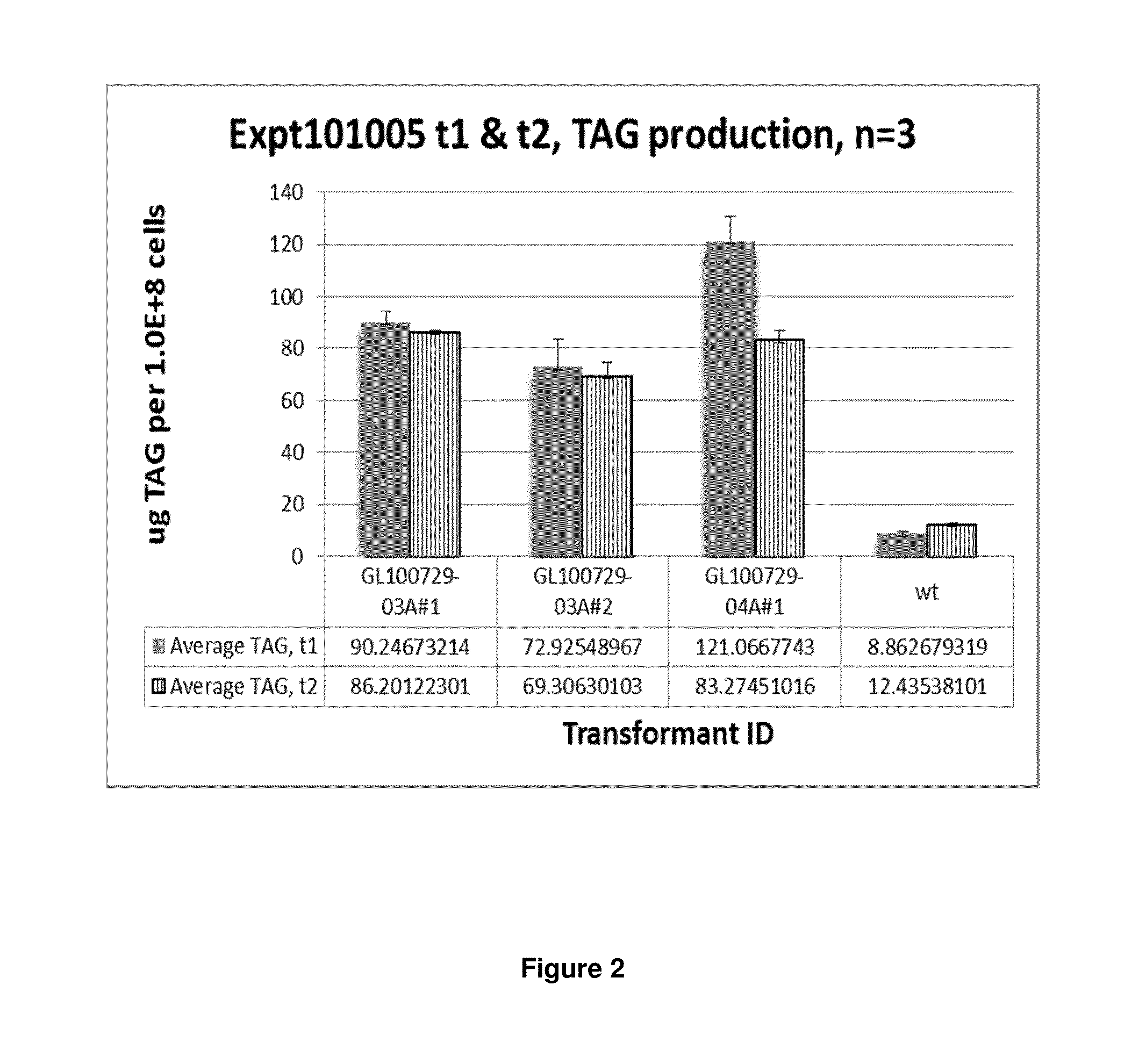DGAT genes and methods of use for triglyceride production in recombinant microorganisms
- Summary
- Abstract
- Description
- Claims
- Application Information
AI Technical Summary
Benefits of technology
Problems solved by technology
Method used
Image
Examples
example 1
Construction of a Vector Containing MmDGAT2A55 Under Control of SV40 Promoter
[0240]The type 2 DGAT (“DGAT2”) from Mus musculus (Accession no. NP—080660; SEQ ID NO:2) is an endoplasmic-reticulum and oil-body associated enzyme responsible for the majority of synthesis of triglyceride (TAG) in cytosolic oil bodies (Stone et al. (2009) J. Biol Chem 284(8): 5352-5361). The knock-out of this gene in M. musculus leads to a lethal phenotype, whereas the type 1 DGAT (“DGAT1”) is dispensable (Yen et al. (2008) J. Lipid Res. 49: 2283-2301). A Nannochloropsis-codon-optimized gene was synthesized (DNA 2.0, Menlo Park, Calif.) (SEQ ID NO:3) encoding a truncated version of the M. musculus DGAT2 lacking the N-terminal 55 amino acids (MmDGAT2Δ55; SEQ ID NO:4). These N-terminal amino acids were hypothesized to encode a mitochondrial localization sequence (Stone et al., 2009) which may be expendable for expression of the enzyme in Nannochloropsis. PCR primers MsDGAT2 F2 (SEQ ID NO:13) and MsDGAT2 R1 (...
example 2
Transformation of Nannochloropsis with GL729 MmDGAT2 Constructs and PCR Screening of Transformants
[0242]Media used for the growth of Nannochloropsis included the following:
[0243]PM023:
[0244]35 g / L Instant Ocean Salts (Aquatic Eco Systems, Apopka, Fla.), 7.1 mM NH4Cl, 0.32 mM NaH2PO4, 10 mM MOPS pH 8.0, 1× Guillard's F / 2 trace metals solution (Final concentration in medium: 11.65 nM Ferric chloride.6H2O; 11.7 nM Disodium EDTA.2H2O; 39.3 nM Cupric sulfate.5H2O, 26 nM Sodium molybdate.2H2O, 76.5 nM Zinc Sulfate.7H2O, 42 nM Cobalt chloride.6H2O, 910 nM Manganese Chloride.4H2O).
[0245]PM027:
[0246]PM023 media, omitting NH4Cl.
[0247]PM010:
[0248]35 g / L Instant Ocean Salts, 1× Guillard's F / 2 marine water enrichment solution (from 50× stock from Sigma-Aldrich, St. Louis, Mo., cat. No. G0154; final concentrations of components in media: 882.5 nM Sodium nitrate; 32 μM Sodium phosphate monobasic; 20.5 nM Biotin; 42 nM Cobalt chloride.6H2O; 40 nM Cupric sulfate.5H2O; 11.65 nM Ferric chloride.6H2O; ...
example 3
TAG Production by Nannochloropsis Transformants
[0256]To determine the effect of the MmDGAT2 transgene on TAG production, the clones were grown in 30 mL cultures in 250 mL shake flasks under 40-50 μE m−2 s−1 shaking at 115 rpm and 25° C. in the presence of ambient 1% CO2. The cells were grown in nitrogen-replete media (PM064), a condition that does not normally lead to TAG production during the exponential growth phase. 5 mL of the inoculation cultures were sampled and submitted for TAG analysis as timepoint t-1. Cultures were then seeded in triplicate at 0.2×107 cells / mL. After 3 days (t1), 10 mL aliquots of each culture were removed, centrifuged briefly, and resuspended in water for a total volume of approximately 500 μL for TAG analysis. The remaining cultures were diluted to approximately 0.1×107 cells / mL so that the cells remained in exponential growth phase. 10 mL of each culture was sampled again at day 7 (t2) in the same manner.
[0257]To determine TAG content of the cells, neu...
PUM
| Property | Measurement | Unit |
|---|---|---|
| Fraction | aaaaa | aaaaa |
| Fraction | aaaaa | aaaaa |
| Time | aaaaa | aaaaa |
Abstract
Description
Claims
Application Information
 Login to View More
Login to View More - R&D
- Intellectual Property
- Life Sciences
- Materials
- Tech Scout
- Unparalleled Data Quality
- Higher Quality Content
- 60% Fewer Hallucinations
Browse by: Latest US Patents, China's latest patents, Technical Efficacy Thesaurus, Application Domain, Technology Topic, Popular Technical Reports.
© 2025 PatSnap. All rights reserved.Legal|Privacy policy|Modern Slavery Act Transparency Statement|Sitemap|About US| Contact US: help@patsnap.com



